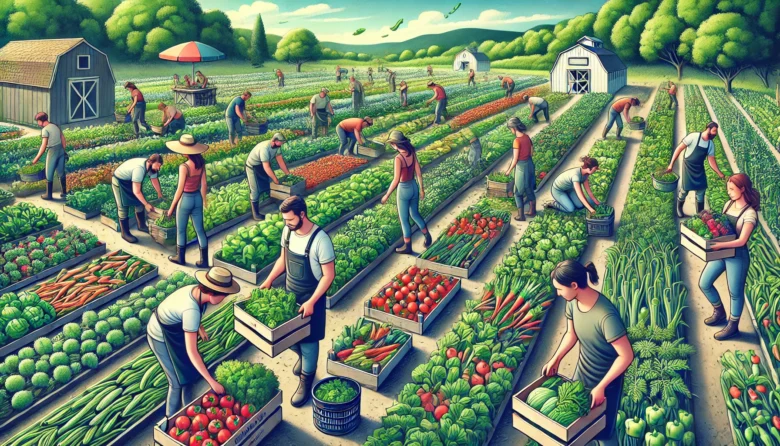In recent years, there has been a growing awareness in India about the importance of sustainable and organic farming practices. One initiative that has been making waves is Community-Supported Agriculture (CSA). The power of Community-Supported Agriculture lies in its ability to connect farmers directly with consumers, fostering a sense of community and ensuring fresh, organic produce reaches our tables.
What is Community-Supported Agriculture (CSA)?
Community-Supported Agriculture (CSA) is a model where consumers, often referred to as “members” or “subscribers,” purchase a share of a farm’s harvest in advance. This arrangement provides farmers with upfront capital to cover their costs and assures consumers a regular supply of fresh, locally-grown produce. Essentially, CSA is a partnership between farmers and consumers, where both parties share the risks and benefits of farming.
Why CSA is Gaining Popularity in India
In India, CSA is becoming popular due to several reasons:
Fresh and Organic Produce: Consumers are increasingly looking for healthier and chemical-free food options. CSA farms typically use organic farming practices, which means the produce is free from harmful pesticides and chemicals.
Supporting Local Farmers: By joining a CSA, members directly support local farmers. This not only helps sustain local agriculture but also ensures farmers receive a fair price for their produce.
Building a Community: CSA fosters a strong sense of community. Members often visit the farm, participate in farming activities, and form a direct relationship with the farmers. This connection enhances the sense of trust and transparency.
Reducing Food Miles: CSA farms supply produce locally, which significantly reduces the carbon footprint associated with long-distance transportation of food.

How CSA Works: A Step-by-Step Guide
Subscription: Consumers sign up for a share of the farm’s produce. This is usually done at the beginning of the growing season.
Payment: Members pay in advance, which provides the farmers with the necessary funds to start the season.
Harvest and Distribution: Throughout the growing season, farmers harvest the crops and distribute them to the members on a regular basis, often weekly or bi-weekly.
Involvement: Members are encouraged to visit the farm, participate in farm activities, and sometimes even help with the harvest.
Success Stories of CSA in India
Several CSA initiatives have been successful across India, highlighting the model’s potential:
Navdanya (an Indian-based non-governmental organization): Founded by environmental activist Vandana Shiva, Navdanya promotes organic farming and biodiversity conservation. Their CSA program connects urban consumers with rural farmers, ensuring a steady supply of organic produce.
Hariyali (a sustainable farming community in Bengaluru): Hariyali operates a CSA program that delivers fresh, seasonal vegetables to its members. Their emphasis on sustainable farming practices has made them a favorite among health-conscious consumers.
Krishi Cress (a farm in Haryana): Specializing in exotic and microgreens, Krishi Cress offers a CSA model where subscribers receive a variety of fresh greens every week. Their focus on high-quality, niche produce has garnered a dedicated customer base.
Benefits of Joining a CSA
Healthier Eating: CSA members receive a regular supply of fresh, seasonal produce, encouraging healthier eating habits.
Economic Support for Farmers: Farmers benefit from the upfront payment and guaranteed market for their produce, reducing their financial risks.
Environmental Impact: Local sourcing of food reduces the carbon footprint, supporting environmental sustainability.
Educational Opportunities: CSA farms often offer educational programs and farm visits, providing members with a better understanding of farming practices and the importance of sustainable agriculture.
Challenges and Solutions
While CSA has numerous benefits, it also faces challenges:
Seasonal Availability: CSA produce is seasonal, which means members might not get their favorite vegetables year-round. However, this encourages consumption of seasonal and diverse diets.
Initial Cost: The upfront payment can be a barrier for some consumers. Many CSAs are addressing this by offering flexible payment plans.
Risk Sharing: Poor harvests due to weather or pests mean members might receive less produce. Transparent communication and educational efforts about the risks involved can help mitigate this issue.
How to Start a CSA in Your Community
If you’re inspired to start a CSA in your community, here are some steps to guide you:
Research and Planning: Understand the local demand for organic produce and identify potential farmers interested in starting a CSA.
Build a Network: Connect with local farmers, consumers, and other stakeholders. Use social media and community meetings to spread the word.
Develop a Business Plan: Outline the logistics, including subscription models, payment plans, distribution methods, and marketing strategies.
Educate and Engage: Organize workshops and farm visits to educate potential members about the benefits of CSA and sustainable farming practices.
Launch and Grow: Start small, and gradually expand as you build a loyal member base. Continuously engage with your community to maintain interest and support.
Conclusion
The power of Community-Supported Agriculture (CSA) lies in its ability to create a sustainable, healthy, and connected community. By joining a CSA, you are not just buying vegetables; you are investing in a local farmer, promoting sustainable agriculture, and becoming part of a community that values fresh, organic, and locally-grown food. Let’s embrace CSA and support our local farmers for a healthier and greener future.
Author’s Note
Thank you for reading! As someone passionate about sustainable living and supporting local farmers, I believe in the transformative power of CSA. Your involvement can make a significant impact. Let’s work together to build a more sustainable and connected community.
G.C., Ecosociosphere contributor.
References and Further Reading
- Navdanya – Promoting Organic Farming and Biodiversity
- Hariyali – Sustainable Farming Community
- Eco-friendly Elegance: UK Cedar Cladding’s Unique Charm – BrookClad. https://uktimbercladding.com/eco-friendly-elegance-uk-cedar-claddings-unique-charm/
- . https://hollandscountryclothing.co.uk/blogs/news/the-challenges-facing-british-farming-and-how-you-can-help




